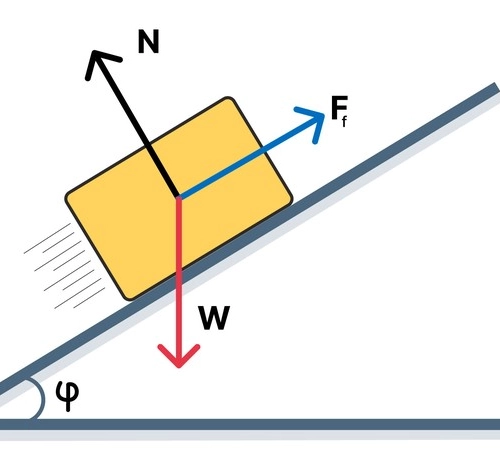
Frictional force, also known as frictional force, is a force that opposes relative motion between two surfaces in contact. This phenomenon is fundamental in the study of dynamics in physics, as it influences how objects move and stop.
Friction is one of the most common forces we encounter in everyday life and plays a crucial role in numerous practical applications and scientific research.
Types of friction
There are several types of friction that can be categorized mainly into two: static friction and kinetic (or dynamic) friction.
- Static friction : This is the force that must be overcome to initiate the movement of an object at rest. This force acts in the opposite direction to the attempted movement and varies up to a maximum value, known as the maximum static friction force. Until this maximum value is reached, the object will not move.
- Kinetic Friction : Once the object starts moving, the friction acting on it is called kinetic friction. This force is generally less than static friction and remains constant as long as the object moves at a constant speed.
Factors affecting friction
Several factors influence the magnitude of the friction force between two surfaces:
- Surface materials : Different materials have different coefficients of friction. For example, rubber on asphalt has a high coefficient of friction, while ice on metal has a much lower coefficient.
- Contact surface : Friction does not depend on the area of contact between surfaces, but on the characteristics of the surfaces themselves and the normal force that keeps them in contact.
- Normal force : Friction is proportional to the normal force, which is the force perpendicular to the contact surfaces. This relationship is expressed as Ffr=μFn, where μ is the coefficient of friction and Fn is the normal force.
Friction force on an inclined surface
 A common case in the study of dynamics is the friction force on an inclined surface.
A common case in the study of dynamics is the friction force on an inclined surface.
As we have said, this force acts in the opposite direction to the movement or tendency of the object to move. Therefore, if the object only experiences the force of gravity, the direction of the friction force is parallel to the surface (same inclination) with an upward direction (since the body tends to move downwards).
On an inclined surface, the weight of the object is divided into two components: one perpendicular to the surface and one parallel. The perpendicular component affects the normal force, which is the force that the surface exerts to support the object. The friction force depends on this normal force.
When the object is at rest, static friction holds the object in place. If the object starts to move, kinetic friction comes into play, usually being less than static friction.
Friction models and theories
The study of friction has evolved over time, and several theories and models have been developed to better understand this phenomenon:
- Amontons-Coulomb Laws : These laws state that friction is proportional to the normal force and is independent of the area of contact. Although these laws are useful in many contexts, they do not explain all aspects of friction.
- Adhesion theory : This model suggests that friction results from adhesive forces between molecules of contacting surfaces.
- Microscopic sliding theory : This theory considers microscopic irregularities in interlocking surfaces that cause friction as they move over each other.
Friction force in a fluid
 Frictional force can also be applied to a fluid. In this case, it is also known as viscous resistance or drag. This force depends on several factors, including the speed of the flow, the viscosity of the fluid, and the shape of the object.
Frictional force can also be applied to a fluid. In this case, it is also known as viscous resistance or drag. This force depends on several factors, including the speed of the flow, the viscosity of the fluid, and the shape of the object.
Viscosity is a measure of the fluid's internal resistance to flow and can be thought of as the "internal friction" of the fluid. The higher the viscosity, the greater the frictional force. For example, water has a lower viscosity than oil, so the drag in water is less than in oil.
Differences between solids and liquids
However, there are significant differences between the frictional forces between solids and fluids. For example, in friction between solids, the force is due to direct interactions between the surfaces in contact, including microscopic irregularities and adhesive forces between the molecules of the surfaces. In contrast, in fluids, friction arises from interactions between fluid layers moving at different speeds.
In the case of solids, the kinetic friction force is generally independent of the speed of the movement once it has started, while in fluids the drag force is proportional to the speed, whether it is a laminar or turbulent flow.
The coefficient of friction in solids is constant for specific materials, while in fluids, the coefficient of drag can vary with the velocity and shape of the object. In addition, the viscosity of fluids changes with temperature and pressure, affecting the drag force. These factors differentiate friction in solids and fluids in practical applications.